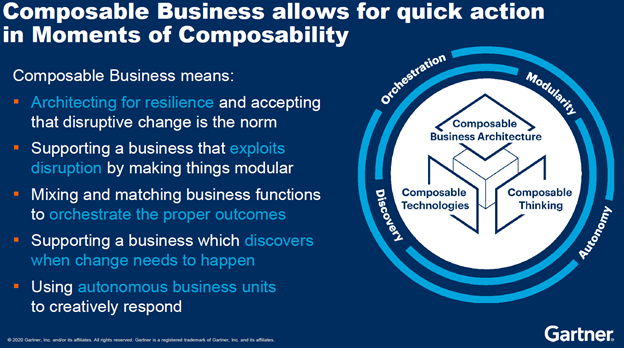![]()
Vala Afshar
| June 14, 2021 — 15:34 GMT (16:34 BST)
| Topic: Digital Transformation

New digital commerce platforms are composable, connected and powered by AI analytics.
According to Gartner, the three building blocks of composable business are:
- Composable thinking, which keeps you from losing your creativity. Anything is composable. When you combine the principles of modularity, autonomy, orchestration and discovery with composable thinking, it should guide your approach to conceptualizing what to compose, and when.Composable business architecture ensures that your organization is built to be flexible and resilient. It’s about structure and purpose. These are structural capabilities — giving you mechanisms to use in architecting your business.Composable technologies are the tools for today and tomorrow. They are the pieces and parts, and what connects them all together. The four principles are product design goals driving the features of technology that support the notions of composability.

Composable business allows for quick action – Gartner
Brands could use the composable approach to improve their site speed and mobile performance by introducing a Progressive Web App, enhancing the commerce experience with store-specific clienteling features or by providing a “buy online, pick-up in store” omnichannel inventory capability. The opportunities are truly limitless!
As with many new trends in technology, developers are the first to embrace it, building with APIs and advancing the concept of headless commerce. Last CyberWeek 2020 alone, Salesforce Commerce Cloud saw over a billion API requests illustrating the breadth of innovation underway. However, over time the trend of composability of enterprise solutions will certainly make its way into hands of business users through low code and no code tools.
But the power of composability does not just stop at providing the building blocks themselves. The secret ingredient of composability is the connective tissue and the end-to-end platform foundation, without which managing a complex architecture over time is about as straightforward as supporting a shaky Jenga tower. There are several connectivity layers required: an API-based approach to application and data connectivity that is scalable across a complex organization; a comprehensive developer platform covering front-end, back-end and middleware (with full flexibility to use third party services where needed); an integrated customer data platform that can connect even the most convoluted shopping journeys and finally, a robust partner ecosystem to enable continuous evolution. Investing in these capabilities will help retailers deliver impactful solutions in the present while paving the road for future innovation.
Delivering a world-class digital commerce experience can feel a bit overwhelming – and for good reason. According to Gartner, many companies struggle with finding the right level of granularity for their digital architectures. A standalone microservice for every small feature is expensive to manage (some call this pattern a “distributed monolith”), yet a loosely coupled architecture is genuinely required for agility and flexibility. Defining and achieving this “techquilibrium” of “just enough technology to get the job done” is the Holy Grail for many organizations investing in digital commerce today. What’s more, it’s not going to look the same from customer to customer. At Salesforce Commerce and Mulesoft, we are focused on delivering the “techquilibrium” with a full platform solution that is uniquely both flexible and designed for interoperability, with the services and support to truly make it yours. This approach has been proven to more than double innovation velocity while reducing TCO for customers, like Revolution Beauty.
It is tough to predict what the new digital touch points or shopping models that will emerge in the years ahead. But one thing is clear: The digital commerce architecture of the future will be built in a way that is composable and connected. And this will surely be a truly exciting future for brands, developers and shoppers alike.
This article was co-authored by Igor Faletski, vice president of products at Salesforce Commerce Cloud and prior co-founder of Mobify (acquired by Salesforce in 2020).
Related Topics:
Thought Leadership
CXO
Innovation
Digital Transformation: A CXOs Guide
Big Data Analytics
![]()
Vala Afshar
| June 14, 2021 — 15:34 GMT (16:34 BST)
| Topic: Digital Transformation